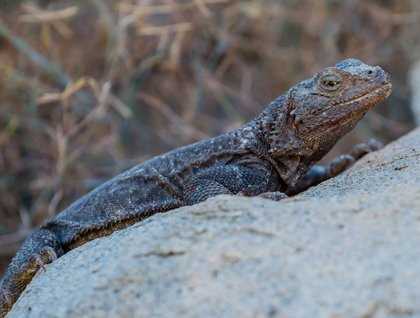En-dem-ic (en-dem ik) 1. Prevalent in or peculiar to a particular locality or people. 2. Ecol. Native or limited to a certain region 3. Med. Peculiar to a particular locality (an endemic disease) -n, Ecol. An endemic plant or animal. –en-dem i-cal-ly adv. –en-dem’ism n.
The day’s first golden rays of light found the National Geographic Sea Bird heading north looking for some of the abundant marine life this nutrient rich area is famous for. Long-beaked common dolphins leisurely joined the ship several times throughout the morning, but apparently had other dolphin appointments to keep, and only teased us with their presence. A single Bryde’s whale kept us all guessing to where it would surface next, once on starboard, then to our stern, next right off the bow, and last at a distance. Mobula rays and giant needlefish, as well as scattered flying fish kept us on the bow eagerly scanning.
Isla Santa Catalina is a unique and beautiful island in the Sea of Cortez. In the early afternoon the ship anchored in her protection, some of us explored the underwater reef, while others went for an aerobic hike up the arroyo to a panoramic view of the island, while others explored the natural history. All kept an eye for the endemic species of reptiles.
Staff and travelers in the know always anticipate visiting offshore islands here in the gulf. Isla Santa Catalina is especially exciting because it is an oceanic island, never having been attached to the Baja Peninsula, unlike most of the other islands in this region.
Of the ten species of reptiles found on Isla Santa Catalina an astounding 80 percent are found no other place in the world. This is one of the most unique reptile habitats in the entire Sonoran Desert.
Keen eyes were searching for the endemic emerald side-blotched lizard, the Isla Santa Catalina chuckwalla, desert iguana, and leaf-toed gecko. But treasure came to us in the form of not one, but three rattleless rattlesnake findings in the arroyo.
The Santa Catalina rattlesnake has evolved to be rattleless, losing the buttons at the end of its tail. Unlike other rattlesnakes it is thin, agile, and adept at climbing trees, probably due to the fact that it preys on birds at night. In addition to birds, this snakes diet includes Santa Catalina spiny lizards, leaf-toed geckos, and deer mice all endemic to the island. This beautiful rattlesnake is dimorphic in dorsal coloration, having an ashy gray and a brown color variation. We observed both morphs on our walks today.
As the sun slipped behind the Baja Peninsula to the west, photographers took the opportunity to paint cactus with light. As sunset turned to twilight, Ursa Major and Orion appeared with numerous friends to light the night sky.









